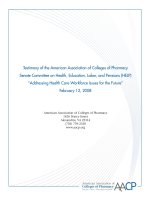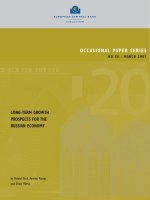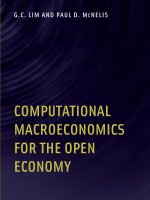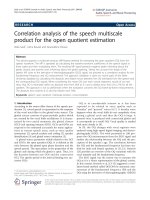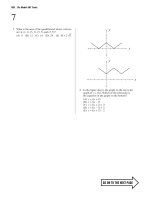computational macroeconomics for the open economy oct 2008
Bạn đang xem bản rút gọn của tài liệu. Xem và tải ngay bản đầy đủ của tài liệu tại đây (3.06 MB, 251 trang )
G.C. Lim and PauL d. mc neLis
ComPutationaL
maCroeConomiCs
for the oPen
eConomy
Computational Macroeconomics for the Open Economy
Computational Macroeconomics for the Open Economy
G. C. Lim and Paul D. McNelis
The MIT Press
Cambridge, Massachusetts
London, England
( 2008 Massachusetts Institute of Technology
All rights reserved. No part of this book may be reproduced in any form by any elec
tronic or mechanical means (including photocopying, recording, or information storage
and retrieval) without permission in writing from the publisher.
MIT Press books may be purchased at special quantity discounts for business or sales
promotional use. For information, please e mail special or write
to Special Sales Department, The MIT Press, 55 Hayward Street, Cambridge, MA 02142.
This book was set in Palatino on 3B2 by Asco Typesetters, Hong Kong and was printed
and bound in the United States of America.
Library of Congress Cataloging in Publication Data
Lim, G. C. (Guay C.)
Computational macroeconomics for the open economy / G. C. Lim and Paul D. McNelis.
p. cm.
Includes bibliographical references and index.
ISBN 978 0 262 12306 8 (hbk. : alk. paper) 1. Econometric models. 2. Macroeconomics
Mathematical models. I. McNelis, Paul D. II. Title.
HB141.L54 2008
339.01
0
5195 dc22 2008011200
10987654321
Contents
Preface xi
Acknowledgments xv
1 Introduction 1
1.1 The Open Economy Setting 1
1.2 Solution Methods 3
1.2.1 Perturbation Method 5
1.2.2 Projection Methods and Accuracy Tests 6
1.3 Policy Goals, Welfare, and Scenarios 13
1.4 Plan of the Book 15
Computational Exercises 17
2 A Small Open Economy Model 19
2.1 Introduction 19
2.2 Flexible Price Model 20
2.2.1 Closure Condition 20
2.2.2 Consumption and Labor 21
2.2.3 Production and Pricing 24
2.2.4 Monetary and Fiscal Authorities 25
2.2.5 Exports and Foreign Debt 27
2.2.6 Calibration 27
2.3 Solution: Projection Method 28
2.3.1 Approximating Functions 28
2.3.2 Euler Errors 29
2.3.3 Accuracy Checks 29
2.4 Stochastic Dynamic Simulations 32
2.4.1 Impulse-Response Analysis 32
2.4.2 Recurring Shocks 34
2.4.3 Welfare Distributions 37
2.5 Effects of a Demand Shock 39
2.5.1 Scenario: Export Shock 39
2.5.2 Stochastic Dynamic Simulations 40
2.6 Concluding Remarks 43
Computational Exercise: Stochastic Processes 43
3 Sticky Domestic Prices 47
3.1 Introduction 47
3.2 Model with Calvo Pricing 49
3.2.1 Households Consumption and Labor 49
3.2.2 Production and Calvo Pricing 50
3.2.3 Government Sector 52
3.2.4 Exports and Foreign Debt 53
3.3 Computational Analysis 53
3.3.1 Approximating Functions 53
3.3.2 Euler Errors 54
3.3.3 Accuracy Checks 54
3.4 Stochastic Simulations 56
3.4.1 Impulse-Response Analysis 56
3.4.2 Macroeconomic Correlations 58
3.4.3 Welfare Analysis 59
3.5 Output Gaps and Sensitivity Analysis 62
3.5.1 Output Gap Environment 62
3.5.2 Taylor Rule with an Output Gap 64
3.6 Concluding Remarks 65
Computational Exercise: Output in the Taylor Rule 66
4 Income and Consumption Taxes 69
4.1 Introduction 69
4.2 Model with Taxes 71
4.2.1 Household Euler Equations 71
4.2.2 Firms Production and Calvo Pricing 72
4.2.3 Monetary Policy 72
4.2.4 Taxes and Domestic Debt 73
4.2.5 Exports and Foreign Debt 73
4.2.6 Calibration 73
4.3 Model Solution 74
4.3.1 Decision Rules 74
4.3.2 Euler Errors 75
4.3.3 Accuracy Checks 75
vi Contents
4.4 Stochastic Simulations 75
4.4.1 Impulse-Response Analysis 75
4.4.2 Welfare Comparisons 78
4.5 Scenario Analysis 79
4.5.1 Alternative Fiscal Policy Regimes 79
4.5.2 Impulse-Responses 80
4.6 Concluding Remarks 82
Computational Exercise: Model Validation with VARs 83
5 Current Account Dynamics 85
5.1 Introduction 85
5.2 Model with Endogenous Exports 86
5.2.1 Households Consumption and Labor 87
5.2.2 Firms One-Sector Production and Pricing 89
5.2.3 Monetary and Fiscal Authorities 89
5.2.4 Exports and Foreign Debt 90
5.3 Computational Analysis 90
5.3.1 Decision Rules and Euler Errors 90
5.3.2 Accuracy Checks 91
5.4 Productivity Shocks 91
5.4.1 Impulse-Response Analysis 91
5.4.2 Stochastic Simulations 93
5.5 Scenario Analysis 94
5.5.1 Low Export Elasticity 94
5.5.2 Government Expenditure 96
5.6 Concluding Remarks 98
Computational Exercise: Real Exchange-Rate Volatility 100
6 Capital and Tobin’s Q 103
6.1 Introduction 103
6.2 Model with Capital Accumulation 105
6.2.1 Householders and Entrepreneurs 105
6.2.2 One-Sector Production 108
6.2.3 Monetary and Fiscal Authorities 109
6.2.4 Exports and Foreign Debt 109
6.3 Solution Algorithm 109
6.3.1 Approximating Equations 109
6.3.2 Accuracy Tests 112
6.4 Stochastic Dynamic Simulations 113
6.4.1 Impulse-Response Functions 113
6.4.2 Macroeconomic Correlations 114
Contents vii
6.5 Scenario Analysis Q Targeting 114
6.5.1 Productivity Shocks 115
6.5.2 Export Shocks 117
6.6 Concluding Remarks 117
Computational Exercise: Risk and Q growth 119
7 Economy with Natural Resources 121
7.1 Introduction 121
7.2 Two-Sector Model 122
7.2.1 Householders and Entrepreneurs 122
7.2.2 Two-Sector Production and Pricing 125
7.2.3 Monetary and Fiscal Authorities 126
7.2.4 Exports and Foreign Debt 127
7.3 Solution Algorithm 127
7.3.1 Euler Errors 128
7.3.2 Accuracy Checks 128
7.4 Simulation Analysis 128
7.4.1 Impulse-Response Paths 128
7.4.2 Stochastic Simulations 131
7.5 Terms-of-Trade Shocks 132
7.6 Concluding Remarks 134
Computational Exercise: Real Exchange Cross-Correlations 135
8 Financial Frictions 139
8.1 Introduction 139
8.2 DSGE Model with Banking 140
8.2.1 Household Sector: Consumption and Saving 140
8.2.2 Firms Production, Pricing, and Borrowing 143
8.2.3 Monetary and Fiscal Authorities 144
8.2.4 Exports and Foreign Debt 145
8.2.5 Financial Sector 146
8.3 Solution Algorithm 147
8.4 Simulation Analysis 149
8.4.1 Impulse-Response Paths 149
8.4.2 Macroeconomic Correlations 150
8.5 Scenario Analysis 152
8.6 Concluding Remarks 152
Computational Exercise: The ‘‘Great Moderation’’ 153
viii Contents
9 Wage Rigidities 157
9.1 Introduction 157
9.2 Model with Sticky Wages 158
9.2.1 Household Sector 158
9.2.2 Firms Production, Pricing, and Loans 161
9.2.3 Monetary Policy 162
9.2.4 Taxes and Domestic Debt 163
9.2.5 Exports and Foreign Debt 163
9.2.6 Financial Sector 163
9.3 Solution Algorithm 164
9.3.1 Approximating Functions 164
9.3.2 Accuracy Checks 165
9.4 Simulation Analysis 165
9.4.1 Impulse-Response Paths 165
9.4.2 Macroeconomic Correlations 167
9.5 Sensitivity Analysis 168
9.6 Concluding Remarks 170
Computational Exercise: Dunlop-Tarshis Puzzle 171
10 Habit Persistence 173
10.1 A DSGE Model with Habit Persistence 174
10.1.1 Household Sector 174
10.1.2 Production Sector 177
10.1.3 Government Sector 178
10.1.4 External Sector 179
10.1.5 Financial Sector 179
10.2 Solution Algorithm 180
10.2.1 Approximating Equations 180
10.2.2 Euler Errors 181
10.2.3 Accuracy Checks 181
10.3 Stochastic Simulations 181
10.3.1 Impulse-Responses to a Productivity Shock 181
10.3.2 Macroeconomic Correlations 183
10.4 Simulating Alternative Scenarios 185
10.4.1 No-Inflation Targeting 185
10.4.2 International Shocks 186
10.5 Concluding Remarks 187
Computational Exercise: Output and Interest Rate 188
Contents ix
11 International Capital Flows and Adjustment 191
11.1 Capital Reversals 192
11.1.1 Sudden Stops and Contagion Effects 192
11.1.2 Simulating a Reversal in Capital Flows 193
11.2 Continuing Inflows 194
11.2.1 Current Account Deficits and Asset-Price Inflation 194
11.2.2 Simulating Continuing Capital Inflows 195
11.3 Future Research 196
Appendixes
A Definition of Symbols 201
B Definition of Variables 203
C The Computer Algorithm 205
Notes 211
Bibliography 215
Index 225
x Contents
Preface
This study comes from the conviction that policy makers need quanti-
tative, not simply qualitative, answers to pressing policy questions.
Policy makers have to make decisions in the real world, and it is often
useful, if not imperative, to augment qualitative advice with specific
numerical ranges for operational targets in the short and medium run.
For example, while it is useful for economic advisors to inform policy
makers about the need for a competitive real exchange rate, or a sus-
tainable trade deficit, it would be even more useful for the advice to
include some benchmark numerical values of the competitive real ex-
change rate, or the sustainable trade balance (given the magnitudes of
the key characteristics of the economy and external conditions)
Quantitative answers have often come from ad hoc back-of-envelope
calculations, or cursory eyeballing of charts and graphs, based on in-
complete partial equilibrium models with simple backward-looking
expectations. Today quantitative policy-useful recommendations can
come from a rigorous analysis of well-specified, internally coherent
macroeconomic models, calibrated to capture key characteristics of
particular real world situations. Good economic policy evaluation
today is thus about providing quantitative, not simply qualitative, an-
swers to pressing questions.
The way toward more effective quantitative policy analysis is
through the use of computational stochastic nonl inear dynamic general
equilibrium models. This study shows how such models may be made
accessible and operational for confronting policy issues in highly open
economies.
Wider use of computational experiments or simulation-based policy
evaluation, based on stochastic nonlinear dynamic general equilibrium
models, is now possible due to recent advances in computational
methods, as well as faster, less costly, and more widely available
computers. Newer algorithms permit the analysis of models which
are not only sufficiently complex so that interesting questions may be
explored, but also tractable enough so that one may be able to assess the
sensitivity of results to particular assumptions and initial conditions.
Furthermore, it is no longer necessary to think linearly. For many
years it was necessary to linearize the nonlinear first-order conditions
of such models around a long-run steady state in order to make these
models operational for estimation, computer simulation, and subse-
quent policy evaluation. Physicist Richard Feynman, for example, asks
the question, why are linear systems so important? There is only one
answer, and that answer, he states, is simply that we can solve them
(see Feynman, Leighton and Sands 1963).
While such lineari zation makes estimation and simulation relatively
fast, it frequentl y throws out the baby with the bath water, since many
of the interesting questions in macroeconomic adjustment—such as
asymmetric response of asset prices to shocks, or the effects of risk on
economic welfare—necessitate explicit nonlinear approaches. For ex-
ample, why do currencies crash spectacularly fast but recover much
more slowly? Such phenomena do not take place in linear symmetric
environments.
More to the point, many of the changes in external or internal envi-
ronments facing decision makers in small highly open economies
hardly represent small or local departures or movements around a
steady state. Similarly the movements of key financial variables, such
as asset-market returns, have hardly been linear and symmetric. As
Franses and van Dijk (2000, p. 5) point out, such returns display erratic
behavior, in the sense that ‘‘large outlying observations occur with
rather high-frequency, large negative returns occ ur more often than
large positive ones, these large returns tend to occur in clusters, and
periods of high volatility are often preceded by large negative returns.’’
Miranda and Fackler (2002, p. xv) point out that economists have
‘‘not embraced numerical methods as eagerly as other scientists’’ per-
haps ‘‘out of a belief that numerical solutions are less elegant or less
general than closed-form solutions.’’ However, the development of
parameterized expectations, collocation methods, neural network ap-
proximation, and genetic algorithms, as well as other methods, have
opened the way to use relatively complex nonlinear models for policy
analysis and evaluation. As Kenneth Judd reminds us in his book,
Numerical Methods in Economics, models, to give meaningful insight to
policy makers, must be simple, but the models should not, and need
xii Preface
not be, too simple. This study shows how state-of-the-art tools may be
used to apply sufficiently complex models in computational experi-
ments to give meaningful insights, under realistic assumptions about
the underlying economic environments.
This book is, in part, a stand-alone research treatise and a stand-
alone graduate textbook. It is like a research treatise in the sense that
it contributes to current research knowledge in the area, but in a more
extensive format than would be common in an academic journal
article. It is like a graduate textbook, in the sense that it aims to help
students and researchers get up to speed on computational method s
and to apply these techniques to interesting questions. Finally, it is a
policy-oriented book, intended to help researchers at central banks
build their own models for ongoing analysis and evaluation.
Of course, all models are limited. As Martin Feldstein observes, in
his tribute to Otmar Issing (when he departed as a member of the
Board of the European Central Bank), our computational models are
‘‘only useful as heuristic devices to help clear our thinking’’ rather
than for specifying real time policies, and that we are ‘‘particularly
poor at open economy issues’’ (Feldstein 2006). We hope that this book
contributes to clear thinking about open economy issues, as well as the
design of better policies even in real time.
While remaining a stand-alone book, this study may also be seen as
a distillation of several ideas coming from Numerical Methods in Eco-
nomics and Foundations of International Macroeconomics. Both of these
books are widely used sources for learning the literature in computa-
tional methods and open economy macroeconomics respectively.
We stress at the outset that this book is concerned with monetary
and fiscal policy, for a prototype small open economy. We do not try
to capture the environment of any economy in particular, through
methods for ‘‘matching moments’’ of simulated and actual data, or
with Bayesian estimation. Rather, we intend to show the important
trade-offs in the conduct of policy under familiar and realistic scenarios
taking place in small open economies throughout the world.
The organization of the material in the book is influenced by our
experience with graduate students and with policy researchers. As pro-
fessors, both of us recognize that students and researchers face signifi-
cant learning setup costs (including psychological adjustment costs!)
when they contemplate the implementation of computational algo-
rithms. Common reactions among many of our current and former
students and colleagues include feelings that they are delving into a
Preface xiii
‘‘black box,’’ that they have to learn the ‘‘art and science’’ of program-
ming cumbersome code, that they have to wait long hours or even
days for computer programs to ‘‘converge,’’ and finally, that they
have to live with the lingering uncertainty about the ‘‘accuracy’’ and
‘‘uniqueness’’ of the numerical results, as well as their policy relevance,
once they have taken the time and trouble to do the computational
work. Small wonder, then, that many prefer to work with simplified,
linear, analytically tractable models, even if the assumptions are at
times highly artificial and abstract.
We wish to show that the ‘‘black box’’ is not as dark as many think
when viewed through the lens of a ‘‘random search’’ solution algo-
rithm, that popular algorithmic methods can be understood rather
quickly and are well worth the investment in time and energy, that
‘‘convergence waiting time’’ is often not that much longer than the
‘‘programming cost’’ of setting up linear models with equally cumber-
some log-linear algebraic approximation, that ‘‘accuracy checks’’ for
models are easily implemented, and that these models yield important
new insights into dynamic macroeconomics for open economies.
xiv Preface
Acknowledgments
McNelis is grateful to the Melbourne Institute of Applied Economic
and Social Research at the University of Melbourne for hospitality and
research support for several extended visits between 2004 and 2007, for
purposes of collaboration with Professor Lim on this project. He also
thanks the Research Visitors Program of the European Central Bank
and the Research Visitor Program of the National Bank of the Nether-
lands for support and hospitality during 2004–2005 academic year in
Frankfurt and Amsterdam, while he continued to work on projects
closely related to material appearing in this book.
Lim thanks the Bendheim Scholar Program of the Department of Fi-
nance of Fordham University Graduate Schoo l of Business for research
support and hospitality in New York in January 2007. She also thanks
Georgetown University and Boston College for facilitating various vis-
its to the United States for the purpose of collaboration with Professor
McNelis.
We wish to acknowledge that MathWorks Inc. has provided recent
versions of MATLAB1 for this project. In the appendix we list the pro-
gramming codes for the results appearing in chapter 2 of this book,
in order to get rea ders started in developing their own computer
algoritms.
1
Lim and McNelis are grateful to Elizabeth Murry, formerly of The
MIT Press, for her encouragement at the start of this project, and to
Jane McDonald of The MIT Press as this book came to its present form.
McNelis dedicates this book to the newest member of the latest gen-
eration of his family, Samantha Nicole Snyder, born February 23, 2004.
Computational Macroeconomics for the Open Economy
1
Introduction
The focus of this book is on a computational approach to the analysis
of macroeconomic adjustments in an open or globalized economy.
Specifying, calibrating, solving, and simulating a model for evaluating
alternative policy rules can appear to be a cumbersome task. There are,
of course, many different types of models to choose from, alternative
views about likely parameter values, multiple approximation methods
to try, and different options about simulation.
In this chapter we give a brief overview of the issues arising from
the agenda we set for this book and the rationale for the structure of
the book, the methodology adopted, and the economic experiments
considered. Since the same solution method will be used throughout
the book, to minimize repetitions, we provide more details here about
the solution method, the approximating functions and the optimiza-
tion algorithms used.
1.1 The Open Economy Setting
This book uses computational experiments to obtain insights about
macroeconomic adjustments in the open economy setting. These anal-
yses can then inform the design of policies such as the best inflation
targeting program or the best tax regime.
Benigno and Woodford (2004) have pointed out, that too often mon-
etary and fiscal policy rules have been discussed in isolation from each
other, but they opt to work in a closed economy setting, within a linear
quadratic framework to yield analytical closed form solutions for mon-
etary and fiscal policy rules. In contrast, we adopt the open economy
setting for our discussion of monetary and fiscal policies and ab andon
the quest for analytical results in favor of numerical approaches. In so
doing, we also extend our discussion of policy issues to encompass
inflation targeting and the problem of recurring deficits or surpluses in
the fiscal and current-account deficits.
Incorporating the open economy setting, of course, raises issues
about international trade and finance, external borrowing conditions
and assumptions about ‘‘closing’’ the open economy. As Schmitt-Grohe
´
and Uribe (2003) have pointed out, there are many alternative ways
to do this, all of which involve further complications to the standard
models used for monetary and fiscal policy analysis.
Discussions about monetary policy, by their very nature, involve
assumptions about price stickiness. In the closed economy setting such
stickiness can come about either in wage or price-setting behavior in
monopolistically competitive markets. Once we move to an open econ-
omy environment, we face stickiness in the pricing of imported goods,
and thus the case of incomplete pass-through of exchange-rate changes
to the prices of imported goods.
The variety of shocks or exogenous forces affecting the economy also
expands when we move to the open economy setting. In addition to
the usual productivity changes driving a business cycle, there are terms
of trade shocks, foreign interest rate developments, and global demand
variables to consider. The open economy setting is much more exposed
to varying types of shocks.
Discussions of optimal policy in the open economy, then, involve
much more complexity than corresponding discussions in the closed
economy setting. The models need to be closed, and there are different
ways to do this (including the use of a two-country model). Further-
more a reasonable case can be made for ‘‘stickiness’’ in the pricing of
imported goods, as well as in domestic price-setting behavior, which
in turn involves both forward and backward-looking behavior in the
imported-goods sector of the economy.
The models we use in this book are in the class of so-called open
economy new neoclassical synthesis (NNS) models. Such models, as
Goodfriend (2002) reminds us, incorporate classical features such as the
real business cycle, as well as Keynesian features, such as monopo-
listically competitive firms and costly price adjustment. As Canzoneri,
Cumby, and Diba (2004) note, such models have been routinely used
to revisit the central issues of st abilization policy.
Different general equilibrium models can generate different effects,
so it is essential to have a good strategy for developing a good dy-
namic stochastic general equilibrium (DSGE) model. As McCallum
(2001) points out, it is desirable for a model to be consistent with both
2 Chapter 1
economic theory and empirical evidence, but this ‘‘dual requirement’’
is only a starting point for consideration of numerous issues. Mc-
Callum also points out that ‘‘depicting individuals as solving dynamic
optimization problems,’’ as is done in general equilibrium settings, is
‘‘useful in tending to reduce inconsistencies and forcing the modeler to
think about the economy in a disciplined way’’ (McCallum 2001, p. 15).
But adhering to dynamic general equilibrium models still leaves room
for enormous differences, as the reader will see as the chapters unfold.
In this book we focus on variations of one prototype model of the
open economy; complexity is introduced, by adding extra economic
features, chapter by chapter. While there are many unresolved issues
about macroeconomic adjustments and the conduct of policy in the
open economy, the differing positions rest on specific assumptions in
the models. Rather than review a myriad of conflicting positions based
on differing models, we work with increasingly complex versions of
the prototype model. The same productivity shock is considered in
each case. However, to gain further insight, we also compare the dy-
namic responses of key variables to other shocks, such as exports and
the terms of trade. The progressive addition of complexity highlights
the contribution of each added economic feature and aids in the under-
standing of the economic results and the derived implications for pol-
icy rules in an open economy setting.
The model is calibrated rather than estimated—the recent develop-
ment of estimation techniques for DSGE models deserves a separate
book. However, the parameters are based on estimates which are
widely accepted. Thus our model is not only completely based on un-
derlying optimization decisions of economic agents, at the household,
firm, and policy-making level, it is also meant to be reasonably realis-
tic. To put this point another way, following Canova (2007), what is
relevant for us is the extent to which our series of ‘‘false’’ models yield
coherent explanations of interesting aspects of data, while maintaining
highly stylized structures (Canova 2007, p. 251). Thus the models we
use are widely shared, if not consensus, benchmarks of how to model
an open economy for policy evaluation.
1.2 Solution Methods
DSGE models, no matter how simple, do not have closed form solu-
tions except under very restrictive circumstances (e.g., logarithmic
utility functions and full depreciation of capital). We have to use
Introduction 3
computational methods if we are going to find out how the models
behave for a given set of initial conditions and parameter values.
However, the results may differ, depending on the solution method.
Moreover there is no benchmark exact solution for this model, against
which we can compare the accuracy of alternative numerical methods.
1
There are, of course, a variety of solution methods. Every practicing
computational economist has a favorite solution method (or two). And
even with a given solution method there are many different options,
such as the functional form to use in any type of approximating func-
tion, or the way in which we measure the errors for finding accurate
decision rules for the model’s control variables. The selection of one
method or another is as much a matter of taste as well as convenience,
based on speed of convergence and the amount of time it takes to set
up a computer program.
Briefly, there are two broad classes of solution methods: pertur-
bation and projection metho ds. Both are widely used and have ad-
vantages and drawbacks. We can illustrate these differences with
reference to the well-known example of an agent choosing a stream of
consumption c
t
that maximizes her utility function U, which then
defines the capital k accumulation, given the production function f
and productivity process z
t
,
max
c
t
X
y
t¼1
b
t
Uðc
t
Þ; ð1:1Þ
k
tþ1
¼ f ðz
t
; k
t
ÞÀc
t
; ð1:2Þ
z
t
¼ rz
t 1
þ e
t
; e
t
@ Nð0; s
2
Þ: ð1:3Þ
The first-order condition for the problem is
U
0
ðc
t
Þ¼bU
0
ðc
tþ1
Þ f
0
ðk
tþ1
Þ: ð1:4Þ
The system has one forward-looking variable for the evolution of c
t
,
and one state variable k
t
that depends on the values of the forward-
looking variable, c
t
, and the previous period’s values k
t 1
. The key to
solving the model is to find ways to represent functional forms (‘‘deci-
sion rules’’)
2
for these controls, as these rules depend on the lagged
values of the state variables. Once we do this, the system becomes fully
recursive and the dynamic process is generated (given an initial value
for k).
4 Chapter 1
1.2.1 Perturbation Method
The first method—the perturbation method—involves a local approxi-
mation based on a Taylor expansion. For example, let hðx
t
Þ represent
the decision rule (or policy function) for c
t
based on the vector of state
variables x
t
¼½z
t
; k
t
around the steady-state x
0
:
hðx
t
Þ¼hðx
0
Þþh
0
ðx
o
Þðx
t
À x
0
Þþ
1
2
h
00
ðx
0
Þðx
t
À x
0
Þ
2
þÁÁÁ:
Perturbation methods have been extensively analyzed by Schmidt-
Grohe
´
and Uribe (2004). The first-order perturbation approach (a first-
order Taylor expansion around the steady state) is identical to the most
widely used solution method for dynamic general equilibrium models,
namely linearization or log linearization of the Eul er equations around
a steady state (for examples, see Uribe 2003). The linear model is then
solved using the methods for forward-looking rational expectations
such as those put forward by Blanchard and Kahn (1980) and later dis-
cussed by Sims (2001).
Part of the appeal of this approach lies with the fact that the solution
algorithm is fast. The linearized system is quickly and efficiently solved
by exploiting the fact that it can be expressed as a state-space system.
Vaughan’s method, popularized by Blanchard and Khan (1980), estab-
lished the conditions for the existence and uniqueness of a rational
expectations solution as well as providing the solution. Canova (2007)
summarizes this method as essentially an eigenvalue–eigenvector de-
composition on the matrix governing the dynamics of the system by
dividing the roots into explosive and stable ones.
This first-order approach can be extended to higher order Taylor
expansions. Moving from a first to a second-order approximation sim-
ply involves adding second-order terms linearly in the specification
of the decision rules. Since the Taylor expansion has both forward-
looking and backward-looking state variables, these methods also use
the same Blanchard-Kahn (1980) method as the first-order approach.
Collard and Julliard (2001a, b) offer first- and second-order perturba-
tion methods in their DYNARE software system.
Log-linearization is an example of the ‘‘change of variable’’ metho d
for a first-order perturbation method. Ferna
´
ndez-Villaverde and
Rubio-Ramı
´
rez (2005) take this idea one step further within the context
of the perturbation method. The essence of the Ferna
´
ndez-Villaverde
and Rubio-Ramı
´
rez approach is to use a first or second-order perturba-
tion method but with transformation of the variables in the decision
Introduction 5
rule from levels to power-functions. Just as a log-linear transformation
is easily applied to the linear or first order perturbation representation,
these power transformations may be done in the same way. The pro-
cess simply involves iterating on a set of parameters for the power
functions, in transforming the state variables, for minimizing the Euler
equation errors. The fin al step is to back out the level of the series from
the power transformations, once the best set of parameters is found.
They argue that this method preserves the fast linear method for effi-
cient solution while capturing model nonlinearities that would other-
wise not be captured by the first-order perturbation method.
We note that the second-order method remains, like the first-order
method, a local method. As such, as Fernandez-Villaverde (2006, p. 39)
observes, it approximates the solution around the deterministic steady
state and it is only valid within a specific radius of convergence. Over-
all, the perturbation method is especially useful when the dynamics of
the model consists of small deviations from the steady-state values of
the variab les. It assumes that there are no asymmetries, no threshold
effects, no types of precautionary behavior, and no big transitional
changes in the economy. The perturbation methods are local approxi-
mations, in the sense that they assume that the shocks represent small
deviations from the steady state.
While these methods are fast and easy to implement, they suffer
from one important drawback: the shocks must be small.
3
First- and
second-order perturbation methods go beyond linearization by making
use of first- and second-order Taylor expansions of the Euler equations
around the steady state. However, both linearization and perturbation
methods leave out any possibility of asymmetric behavior widely
observed in the adjustme nt of asset prices and other key macroeco-
nomic variables. While this is fine for discussion of very small shocks,
it is limiting for large or recurring disturbances.
1.2.2 Projection Methods and Accuracy Tests
This book applies the projection method to solve the DSGE models.
The solution method seeks decision rules for c
t
that are ‘‘rational’’ in
that they satisfy the Euler equation (1.4) in a sufficiently robust way.
It may be viewed intuitively as a computer analogue of the method of
undetermined coefficients. The steps in the algorithm are as follows:
Specify decision rules for the forward looking variables; for example,
^
cc
t
¼ f ðW; x
t
Þ, where W are parameters, x
t
are explanatory variables and
f is an approximating function.
6 Chapter 1



